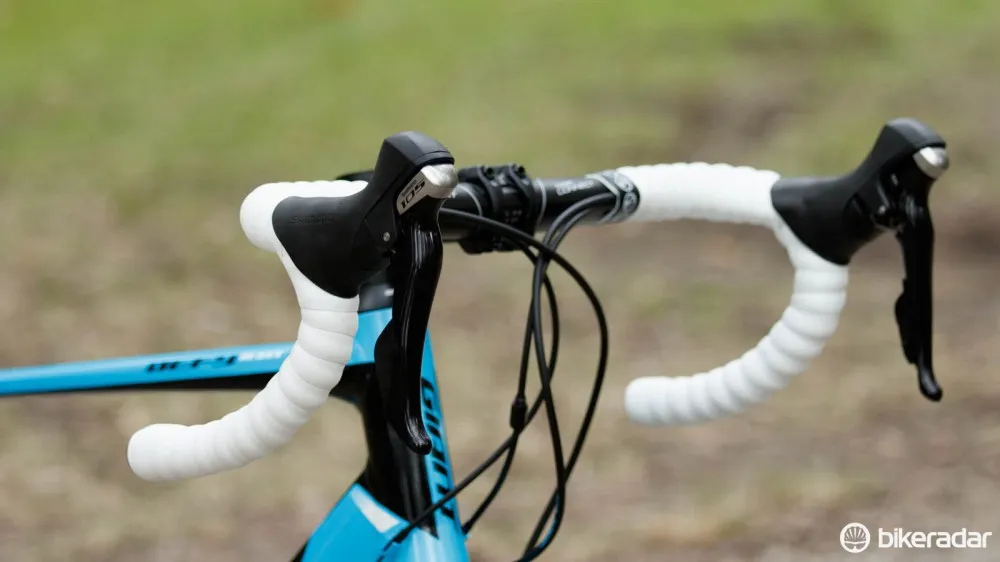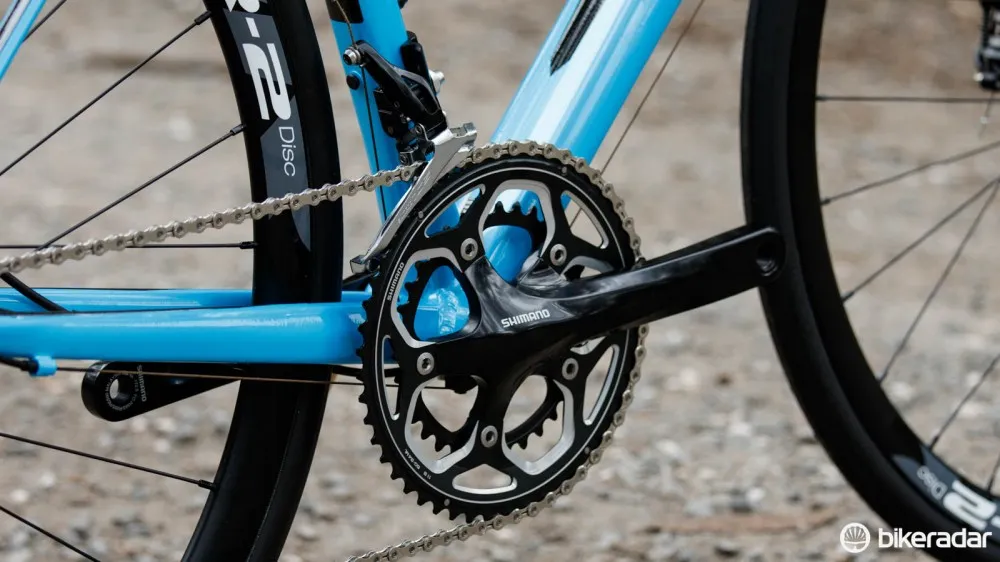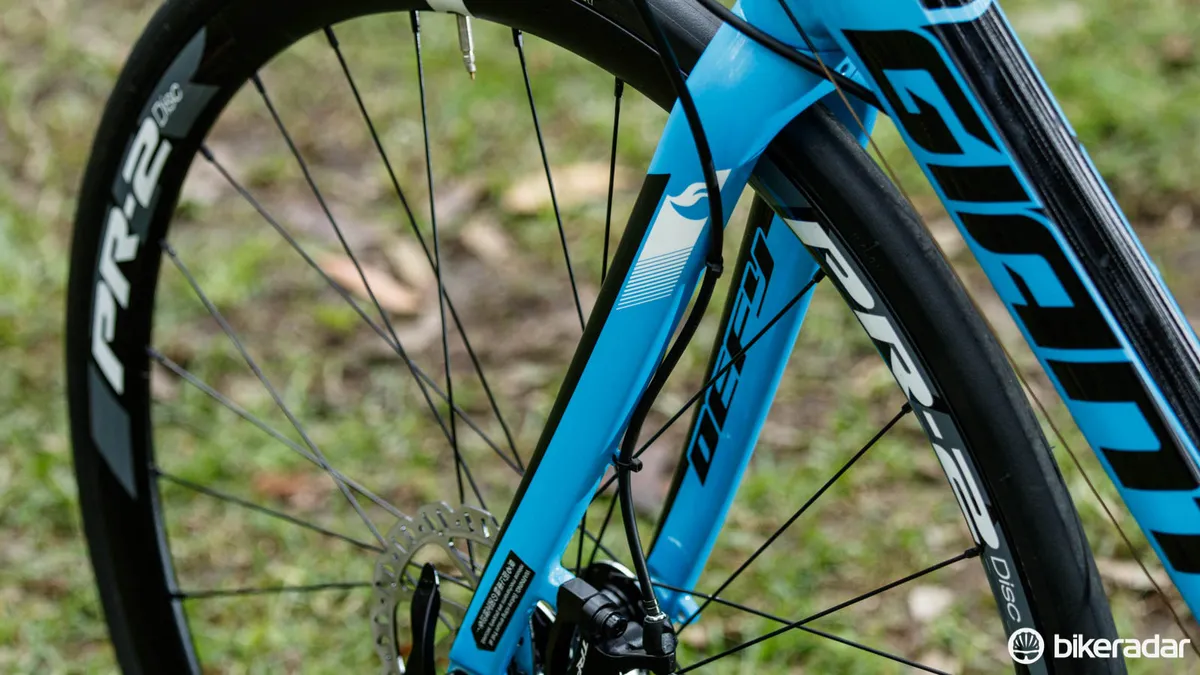In 2015, Giant revamped its performance Defy and women’s Liv Avail range, adding disc brakes to many of the carbon models. Prior to that, the Taiwanese behemoth had tweaked its entry-level alloy range with a frame that pushed the boundaries of what’s possible in aluminium.
For 2016, the world’s largest bicycle manufacturer steps forward again, trickling down the disc brakes of the upper-tier models and merging them with the alloy frame that takes multiple design cues from the carbon models. It’s clear that not all road riders are sold on disc brakes yet. But there’s little denying the benefits provided by the increased braking control – regardless of the weather.
Pricing for the new Defy is a very competitive US$1,500 / AU$1,799 – only marginally more than the 2015 model; UK prices are due to be set in early August 2015 and we'll update you as soon as we have them.
- Highs: Price, quality frame, assured handling, highly functional and durable spec
- Lows: More rattle than its carbon counterparts, proprietary seatpost, a little portly at the wheels
- Buy if: You’re on a budget, but not willing to skimp on durability or ride confidence.
A genuinely solid and refined companion
Built to best fit the newer or less out-and-out performance-focused rider, the Defy range is pitched as an ‘endurance’ bike. Put simply, this means the fit of the bike is more upright and the handling more relaxed compared with traditional race machines.
For most people who see cycling as a hobby or a means to fitness, the endurance category has become the standard – enabling a more comfortable position for the majority of people who spend more hours of the week at a desk than at any other activity.

Giant's Compact Road means the frame sizing must be measured differently from more traditional frames, but a choice of six sizes should keep the majority comfortable
Riding the Defy is a comfortingly familiar experience. The proven geometry and angles haven’t changed greatly over the years, and nor do they need to. You might argue that it’s not the most thrilling ride next to some shorter and snappier options, but it handles high-speed descents with poise and steadily takes whatever bends the road throws its way.
Smaller bumps and road inconsistencies are dealt with by the generous 25c tyres and wide rims, as the bike hums along nicely at speed.
However, hit a poorly surfaced road and it's clear the comfort-focused frame features don’t do quite as much as your eyes would lead you to believe – after all, it’s still a thin-walled alloy frame. Over the roughest of surfaces, there’s a little chatter to be felt and you’ll most likely want to stand above the saddle for the worst sections.
It's worth emphasising that this is by no means a major negative – the Defy handles such surfaces better than most alloy frames, and even many carbon ones. The high volume rubber and slight heft to the bike do enough to keep it planted on rough downhills, preventing the Defy from skipping nervously on fast descents.
Up front, a long alloy steerer tube accompanies the tall head tube, allowing for generous handlebar height adjustment. More flexible riders may wish for a lower position – something that can be achieved with a stem swap – but most will find the given reach perfectly comfortable.

Not as stiff as a thru-axle – hard sprints revealed the slightest sound of disc rubbing
While the rest of the frame is stiff under power, cranking out of the saddle reveals the slightest amount of flex at the quick release dropouts. This is only apparent by the hiss of the brake pads rubbing the rotors, and truthfully you’re never going to lose a street sign sprint over such an insignificant occurrence.
Masterful use of metal in a carbon-like aesthetic
As the world’s leading bicycle manufacturer, Giant has taken the designs and concepts learnt from carbon frames and shaped them into aluminium form.
Just a few years ago, the Defy’s frame shapes would have been thought of as impossible in alloy; however, advancements in ‘hydroforming’ techniques have changed that. Hydroforming is where metal is put under immense liquid pressure, forcing the metal to conform to shapes dictated by a mould.

The head tube is the only round shape on the whole frame
With this, the Defy Disc frame features near square-like tube profiles, with a flat and wide top tube that flows into a ‘D’ shaped seat tube (round with a flat back). From here, and far lower down, the ultra flat seatstays connect. The frame’s down tube continues with the square profiles. In fact, the only round tube to be found is the head tube.
Similar shapes are found in the recently-revamped Defy Advanced range, where the intention is for them to act as leaf-springs and help to promote vertical flex, while the wide profiles resist unwanted torsional flex. It’s worth noting though that carbon's directional nature allows engineers to layer up the material in order to work efficiently and desirably with these given shapes, while metal frame construction doesn’t provide so many tuneable variables.
Our medium sample weighed 1408g including the twin bolt seatclamp, bidon cage bolts and bottom bracket cable guide. This is certainly no flyweight next to the latest 800-900g carbon frames, but it’s a competitive number for a bike of this price.

Giant's D-Fuse seat tube and seatpost
The previously mentioned ‘D-shaped’ seat tube houses a similarly shaped carbon seatpost. Giant calls this technology ‘D-Fuse’, where the flat back is designed to promote greater vertical flex than a traditional round seatpost, and also carries the bonus of being self-straightening. The clear negative is that you’re locked into Giant’s limited seatpost choices – no other brands are offering aftermarket options at the time of writing.
Up front sits a slender disc-only fork. While the fork legs are carbon composite, its tapered steerer tube is alloy, as are the dropouts – leading to a weight of 510g. A post brake mount is given, as are fender/mudguard mounts. Keeping stem compatibility wide open, the steerer tube tapers to a standard 1 1/8in, rather than larger 1 1/4in size found on Giant’s premium road bikes.
Going against the burgeoning trend for thru-axles on disc brake road bikes, both front and rear wheels attach via traditional quick release skewers. Giant has previously said it’ll keep with quick releases until a better market standard presents itself – stating that most thru-axles are overbuilt for road bikes, having been original designed for mountain biking.
While thru-axles would be nice, the use of quick releases opens up suitably priced hub choices and the system does work – allowing for the very slightest of flex.
Bucking another trend is the externally routed cabling. While it may not be as pretty or ready to accept electronic shifting, it remains the lightest and easiest to service option.

Brake and gear cables are easily accessible for service
A nice touch is how the gear cables are guided from the sides of the head tube, creating shorter housing loops and preventing paint rub. Unfortunately the same can’t be said for the full-length brake cable, which does contact the head tube before it is guided along the bottom of the square down tube.
Helping to keep things light is an integrated sealed bearing headset and Shimano press-fit bottom bracket. The headset did suffer from some heavy resistance at new, an issue we remedied with micro-shims placed beneath the headset’s top cover. This is something your place of purchase should fix before it reaches your hands.
Given how aesthetics are so personal, they're something we don’t set much store by too often. However, we got more compliments testing this ride then we’ve received from any other bike, so it's clear the metallic blue paint passes muster. This is undoubtedly a steed that looks more expensive than it really is.

Fender mounts could be used for light pannier loads too
Finally, for those looking to ride in poor weather, the fork fork (as mentioned above) and frame each feature fender mounts, which could also be used to carry light panniers. Like many other road bikes at the entry-level, this opens the versatility of the Defy for fast-paced daily commuting.
Giant’s bargain-producing ability shows again

Disc brakes are no doubt the big story of this ride
For most, the disc brakes will be the main point of interest on this ride. The TRP Spyre mechanical brakes are a top choice at this price point, and where most mechanical brake models work by moving just one brake pad, the Spyres clamp centrally onto the rotor by moving both pads in unison.
Good brakes aren’t about being able to lock a wheel – a caliper brake already does that a little too well. Where disc brakes are superior is being able to finely control the power of your brakes without locking the wheel, and this increased brake modulation means your stopping distances are decreased and riding confidence (and safety) increased.
Another major benefit to discs is durability. Here, the disc brakes pads will greatly outlast a rubber brake block and never wear down a rim; additionally, without needing a rim surface for brake control, slightly out of true wheels can be ridden.

Shimano 105 shifters are usually without complaint, but not this time
Linked to the disc brake calipers are Shimano 105 22-speed levers. These are a truly dependable and proven option, with smooth shifting offered.
However, the use of disc brakes does open up a complaint not commonly heard with the 105 shifters. Placed at the hub, the disc brakes require longer cable, leading to greater friction. Contaminated or dry cables seem to be a little too much for the return springs in the 105 levers and Spyre brakes, and so we experienced some rattling at the brake levers (only when not being held).
We remedied this with some lube through the cable housing, but it could be permanently fixed if there was a stronger return spring in the caliper or perhaps at the lever.

This non-series Shimano crank is slightly wider to overcome the wider disc frame
The rest of the Shimano drivetrain is all quality, and many newer riders will love the enormous gear range afforded by the compact crank and 11-32t cassette. The non-series Shimano RS550 crank is just 60g heavier than its 105 equivalent, but has been used due to a 4mm increase in stance width (2mm per side). This is something that helps to provide more heel clearance at the back of the frame where the disc brake sits.
While they provide great confidence, the disc brakes come with a weight penalty. The brake calipers and rotors are heavier than standard rim brakes, but more obvious on the scales are the heavy-duty disc brake wheels.

Strong rims and a high spoke count help create durable, but heavy wheels
We weighed our Giant PR-2 wheelset at 2040g bare. This additional weight is certainly felt while ascending or accelerating the bike. Thankfully, this weight does come with secure stiffness and a build that should prove durable long-term.
Wrapping the disc brake rims are Giant’s own P-SL1 25c slicks with front and rear specific compounds for greater grip out front, and more durable rubber at rear. Don’t be afraid of the fully slick design, as the rubber compounds mean you have confident grip on a range of road surfaces. And not saying it can’t happen, but we didn’t experience any flats during our testing.
We found the Defy’s carbon D-Fuse seatpost didn't provide quite as much forgiveness as the designers may claim. Furthermore, the relatively cheap single-bolt head means there’s not an infinite amount of saddle angle adjustment, and so you’re often compromising on the ‘nearest’ allowable saddle angle.

It's quite comfortably padded, but the 135mm width is fairly narrow these days
Mounted to the seat post is a Giant-branded saddle made by Velo. This fi’z:ik Arione lookalike is well padded and is reasonably comfortable, but it’s a little narrow by modern standards and many will get better sit-bone support by swapping it out. Beyond our minor complaints around seatpost and saddle, the rest of the alloy cockpit components are quality items from Giant’s list.
With choices from just about every brand, and quite a number of cheaply equipped carbon framed options, this price category remains one of the more confusing ones. We really enjoyed our time riding the Defy 1 Disc and feel it’s one of the very best in its category. Put simply, if you’re not interesting in racing and your budget doesn’t stretch further – then add this bike to your short list immediately.
Since writing this, the Giant Defy 1 Disc has been selected for a 2015 BikeRadar Editor's Pick Award - see more here.




















